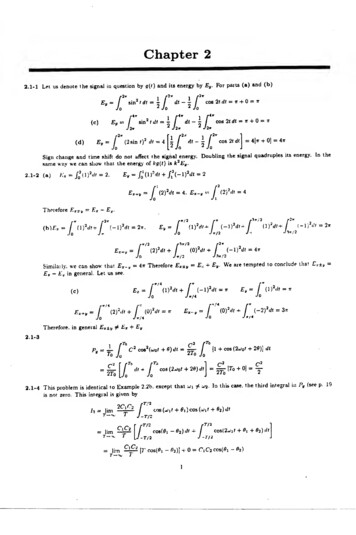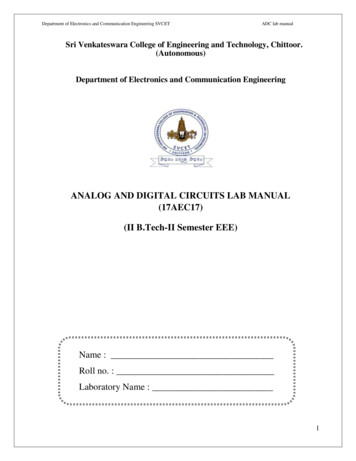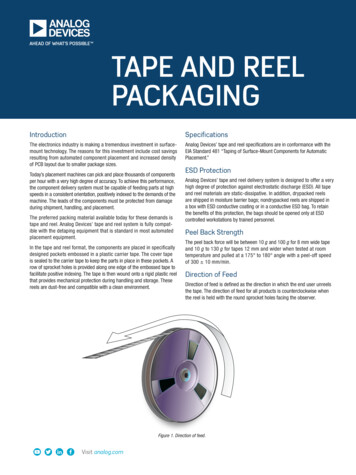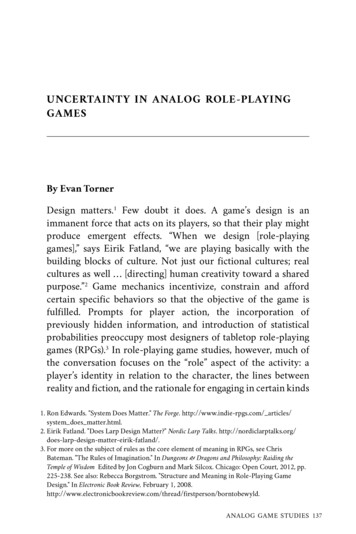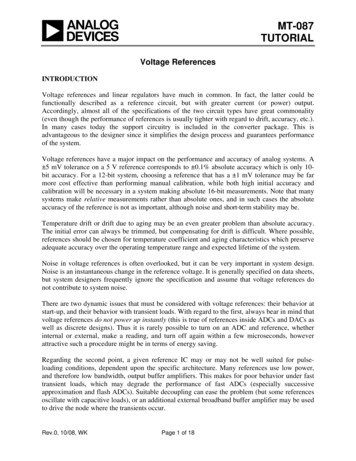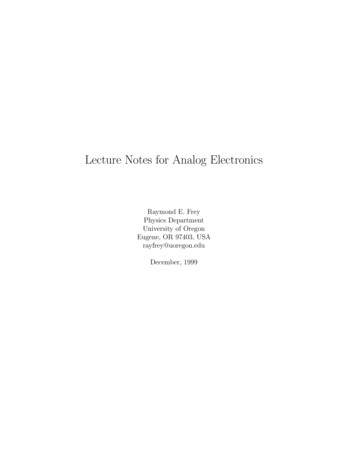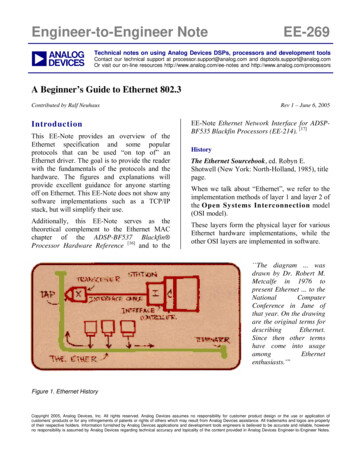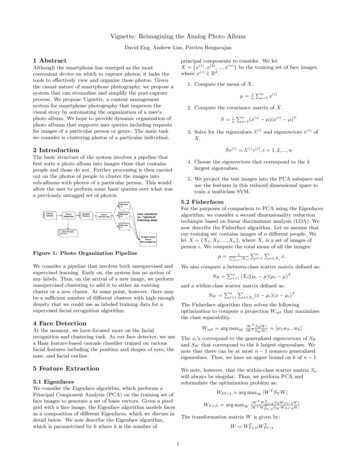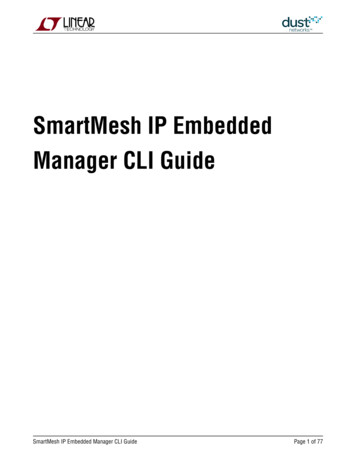
Transcription
The first person to inventa car that runs on water may be sitting right in your classroom! Everyone of your students has the potential to make adifference. And realizing that potential startsright here, in your course.When students succeed in your course—whenthey stay on-task and make the breakthrough thatturns confusion into confidence—they areempowered to realize the possibilities for greatness that lie within each of them. We know your goal is to create an environment where students reach their full potential and experience theexhilaration of academic success that will last them a lifetime. WileyPLUScan help you reach that goal.WileyPLUS is an online suite of resources—includingthe complete text—that will help your students: come to class better prepared for your lectures get immediate feedback and context-sensitive help on assignmentsand quizzes track their progress throughout the course“I just wanted to say how much this program helped mein studying I was able to actually see my mistakes andcorrect them. I really think that other students shouldhave the chance to use WileyPLUS.”Ashlee Krisko, Oakland Universitywww.wiley.com/college/wileyplus80%of students surveyed said it improvedtheir understanding of the material. *
FOR INSTRUCTORSWileyPLUS is built around the activities you perform in your class each day. With WileyPLUS you can:Prepare & PresentCreate AssignmentsTrack Student ProgressCreate outstanding class presentationsusing a wealth of resources such asPowerPoint slides, image galleries,interactive simulations, and more.You can even add materials you havecreated yourself.Automate the assigning and grading ofhomework or quizzes by using the provided question banks, or by writing yourown.Keep track of your students' progressand analyze individual and overall classresults.Now Available with WebCT and Blackboard!“It has been a great help,and I believe it has helpedme to achieve a bettergrade.”Michael Morris,Columbia Basin CollegeFOR STUDENTSYou have the potential to make a difference!WileyPLUS is a powerful online system packed with features to help you make the mostof your potential and get the best grade you can!With WileyPLUS you get: A complete online version of your textand other study resources. Problem-solving help, instant grading,and feedback on your homework andquizzes. The ability to track your progress andgrades throughout the term.For more information on what WileyPLUS can do to help you and your students reach their potential,please visit www.wiley.com/college/wileyplus.76%of students surveyed said it madethem better prepared for tests. **Based on a survey of 972 student users of WileyPLUS
Introduction to Analogand Digital Communications
This page intentionally left blank
Introduction to Analogand Digital CommunicationsSecond EditionSimon HaykinMcMaster University, Hamilton, Ontario, CanadaMichael MoherSpace-Time DSP, Ottawa, Ontario, CanadaJOHN WILEY & SONS, INC.
ASSOCIATE PUBLISHER Dan SayreSENIOR ACQUISITIONS EDITOR AND PROJECT MANAGERPROJECT EDITOR Gladys SotoMARKETING MANAGER Phyllis Diaz CerysEDITORIAL ASSISTANT Dana KellogSENIOR PRODUCTION EDITOR Lisa WojcikMEDIA EDITOR Stefanie LiebmanDESIGNER Hope MillerSENIOR ILLUSTRATION EDITOR Sigmund MalinowskiCOVER IMAGE Photodisc/Getty ImagesCatherine ShultzThis book was set in Quark by Prepare Inc. and printed and bound by Hamilton Printing. The cover was printedby Phoenix Color Corp.This book is printed on acid free paper. Copyright 2007 John Wiley & Sons, Inc. All rights reserved. No part of this publication may be reproduced,stored in a retrieval system, or transmitted in any form or by any means, electronic, mechanical, photocopying,recording, scanning, or otherwise, except as permitted under Sections 107 or 108 of the 1976 United States Copyright Act, without either the prior written permission of the Publisher, or authorization through payment of theappropriate per-copy fee to the Copyright Clearance Center, Inc., 222 Rosewood Drive, Danvers, MA 01923,(978)750-8400, fax (978)646-8600, or on the web at www.copyright.com. Requests to the Publisher for permission should be addressed to the Permissions Department, John Wiley & Sons, Inc., 111 River Street, Hoboken, NJ 07030-5774, (201)7486011, fax (201)748-6008, or online at http://www.wiley.com/go/permissions.To order books or for customer service please, call 1-800-CALL WILEY (225-5945).ISBN-13 978-0-471-43222-7ISBN-10 0-471-43222-9Printed in the United States of America10 9 8 7 6 5 4 3 2 1
To the 20th Century pioneers in communications who,through their mathematical theories and ingenious devices,have changed our planet into a global village
This page intentionally left blank
PREFACEAn introductory course on analog and digital communications is fundamental to the undergraduate program in electrical engineering. This course is usually offered at the junior level.Typically, it is assumed that the student has a background in calculus, electronics, signalsand systems, and possibly probability theory.Bearing in mind the introductory nature of this course, a textbook recommended forthe course must be easy to read, accurate, and contain an abundance of insightful examples, problems, and computer experiments. These objectives of the book are needed toexpedite learning the fundamentals of communication systems at an introductory level andin an effective manner. This book has been written with all of these objectives in mind.Given the mathematical nature of communication theory, it is rather easy for thereader to lose sight of the practical side of communication systems. Throughout the book,we have made a special effort not to fall into this trap. We have done this by movingthrough the treatment of the subject in an orderly manner, always trying to keep the mathematical treatment at an easy-to-grasp level and also pointing out practical relevance of thetheory wherever it is appropriate to do so.Structural Philosophy of the BookTo facilitate and reinforce learning, the layout and format of the book have beenstructured to do the following: Provide motivation to read the book and learn from it. Emphasize basic concepts from a “systems” perspective and do so in an orderly manner. Wherever appropriate, include examples and computer experiments in each chapter to illustrate application of the pertinent theory. Provide drill problems following the discussion of fundamental concepts to help the userof the book verify and master the concepts under discussion. Provide additional end-of-chapter problems, some of an advanced nature, to extend thetheory covered in the text.Organization of the book1. MotivationBefore getting deeply involved in the study of analog and digital communications, it is imperative that the user of the book be motivated to use the book and learnfrom it. To this end, Chapter 1 begins with a historical background of communication systems and important applications of the subject.2. Modulation Theory Digital communication has overtaken analog communications as thedominant form of communications. Although, indeed, these two forms of communicationswork in different ways, modulation theory is basic to them both. Moreover, it is easiest tounderstand this important subject by first covering its fundamental concepts applied to analog communications and then moving on to digital communications. Moreover, amplitudemodulation is simpler than angle modulation to present. One other highly relevant point isthe fact that to understand modulation theory, it is important that Fourier theory be mastered first. With these points in mind, Chapters 2 through 7 are organized as follows:ix
xAPPENDIX 1 POWER RATIOS AND DECIBEL Chapter 2 is devoted to reviewing the Fourier representation of signals and systems. Chapters 3 and 4 are devoted to analog communications, with Chapter 3 covering amplitude modulation and Chapter 4 covering angle modulation. Chapter 5 on pulse modulation covers the concepts pertaining to the transition from analog to digital communications. Chapters 6 and 7 are devoted to digital communications, with Chapter 6 covering baseband data transmission and Chapter 7 covering band-pass data transmission.3. Probability Theory and Signal Detection Just as Fourier analysis is fundamental to modulation theory, probability theory is fundamental to signal detection and receiver performanceevaluation in the presence of additive noise. Since probability theory is not critical to theunderstanding of modulation, we have purposely delayed the review of probability theory,random signals, and noise until Chapter 8. Then, with a good understanding of modulationtheory applied to analog and digital communications and relevant concepts of probabilitytheory and probabilistic models at hand, the stage is set to revisit analog and digital communication receivers, as summarized here: Chapter 9 discusses noise in analog communications. Chapter 10 discusses noise in digital communications. Because analog and digital communications operate in different ways, it is natural to see some fundamental differencesin treating the effects of noise in these two chapters.4. Noise The introductory study of analog and digital communications is completed in Chapter 11. This chapter illustrates the roles of modulation and noise in communication systemsby doing four things: First, the physical sources of noise, principally, thermal noise and shot noise, are described. Second, the metrics of noise figure and noise temperature are introduced. Third, how propagation affects the signal strength in satellite and terrestrial wireless communications is explained. Finally, we show how the signal strength and noise calculations may be combined to provide an estimate of the signal-to-noise ratio, the fundamental figure of merit for communication systems.5. Theme Examples In order to highlight important practical applications of communicationtheory, theme examples are included wherever appropriate. The examples are drawn fromthe worlds of both analog and digital communications.6. AppendicesTo provide back-up material for the text, eight appendices are included at theend of the book, which cover the following material in the order presented here: Power ratios and the decibel Fourier series Bessel functions The Q-function and its relationship to the error function Schwarz’s inequality Mathematical tables
xiPreface Matlab scripts for computer experiments to problems in Chapters 7–10 Answers to drill problems7. Footnotes, included throughout the book, are provided to help the interested reader to pursue selected references for learning advanced material.8. Auxiliary Material The book is essentially self-contained. A glossary of symbols and abibliography are provided at the end of the book. As an aid to the teacher of the course usingthe book, a detailed Solutions Manual for all the problems, those within the text and thoseincluded at the end of chapters, will be made available through the publisher: John Wileyand Sons.How to Use the BookThe book can be used for an introductory course on analog and digital communicationsin different ways, depending on the background of the students and the teaching interestsand responsibilities of the professors concerned. Here are two course models of how thismay be done:COURSE MODEL A: FULL TWO-SEMESTER COURSE(A.1) The first semester course on modulation theory consists of Chapters 2 through 7, inclusive.(A.2) The second semester course on noise in communication systems consists of Chapters 8through 11, inclusive.COURSE MODEL B: TWO SEMESTER COURSES,OTHER ON DIGITALONE ONANALOG ANDTHE(B.1) The first course on analog communications begins with review material from Chapter 2on Fourier analysis, followed by Chapter 3 on amplitude modulation and Chapter 4 onangle modulation, then proceeds with a review of relevant parts of Chapter 8 on noise,and finally finishes with Chapter 9 on noise in analog communications.(B.2) The second course on digital communications starts with Chapter 5 on pulse modulation,followed by Chapter 6 on baseband data transmission and Chapter 7 on digital modulation techniques, then proceeds with review of relevant aspects of probability theory inChapter 8, and finally finishes with Chapter 10 on noise in digital communications.Simon HaykinAncaster, Ontario, CanadaMichael MoherOttawa, Ontario, Canada
This page intentionally left blank
ACKNOWLEDGEMENTSThe authors would like to express their deep gratitude to Lily Jiang, formerly of McMaster University for her help in performing many of thecomputer experiments included in the text. Wei Zhang, for all the help, corrections, and improvements she has made to the text.They also wish to thank Dr. Stewart Crozier and Dr. Paul Guinand, both of the Communications Research Centre, Ottawa, for their inputs on different parts of the book.They are also indebted to Catherine Fields Shultz, Senior Acquisitions Editor andProduct Manager (Engineering and Computer Science) at John Wiley and Sons, Bill Zobristformerly of Wiley, and Lisa Wojcik, Senior Production Editor at Wiley, for their guidanceand dedication to the production of this book.Last but by no means least, they are grateful to Lola Brooks, McMaster University,for her hard work on the preparation of the manuscript and related issues to the book.xiii
This page intentionally left blank
CONTENTSChapter 1 Introduction11.1Historical Background11.2Applications1.3Primary Resources and Operational Requirements1.4Underpinning Theories of Communication Systems1.5Concluding Remarks4131416Chapter 2 Fourier Representation of Signals and Systems2.1The Fourier Transform2.2Properties of the Fourier Transform2.3The Inverse Relationship Between Time and Frequency2.4Dirac Delta Function2.5Fourier Transforms of Periodic Signals2.6Transmission of Signals Through Linear Systems: ConvolutionRevisited 522.7Ideal Low-pass Filters2.8
Chapter 10 discusses noise in digital communications. Because analog and digital com-munications operate in different ways, it is natural to see some fundamental differences in treating the effects of noise in these two chapters. 4. Noise The introductory study of analog and digital communications is completed in Chap-ter 11. This chapter illustrates the roles of modulation and noise
